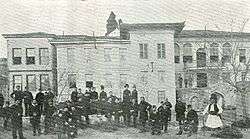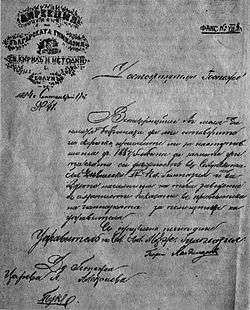Bulgarian Men's High School of Thessaloniki


The Sts. Cyril and Methodius Bulgarian Men's High School of Thessaloniki[1] (Bulgarian: Солунска българска мъжка гимназия „Св. св. Кирил и Методий“, Solunska balgarska mazhka gimnazia „Sv. sv. Kiril i Metodiy“) [2] was the first Bulgarian high school in Macedonia. One of the most influential Bulgarian educational centres in Macedonia, it was founded in autumn 1880[3] in Ottoman Thessaloniki (today in Greece) and existed until 1913.[4]
Foundation
The first Bulgarian language school in Thessaloniki was founded in 1871 next to the church of Agios Athanasios. Following the April Uprising of 1876, the Russo-Turkish War of 1877-1878, the Kresna-Razlog Uprising and other events, the Bulgarian educational cause in Macedonia had to live through a number of blows. Exploiting anti-Bulgarian sentiment among government officials, Greek bishops succeeded in shutting down a lot of Bulgarian schools and in re-introducing the Greek language to Bulgarian churches in the region. As a result, part of the Bulgarian intelligentsia emigrated to the Principality of Bulgaria and the province of Eastern Rumelia. They did, however, manage to continue their work, supported by local municipalities, the Bulgarian Exarchate, and the newly created Bulgarian state. The situation in Thessaloniki remained relatively calm, given the hard situation elsewhere. The presence of foreign consuls and representations was putting some limitations on the Turkish regime. This fact is asserted by some scholars as the main reason behind the opening of a Bulgarian secondary school in Macedonia resembling the ones in Sofia and Plovdiv.[5] In 1880 the Ottoman Empire adopted an Act on Vilaets which limited Greek bishops’ control over Bulgarian churches. Taking advantage of these developments, revivalist Kuzman Shapkarev prepared a whole plan for Bulgarian education in Macedonia, centred on the region’s capital – Thessaloniki. The city ought to host one men’s and one girls’ gymnasium with boarding schools attached to each. Prior to their opening, there was a total of 667 Bulgarian basic schools in Macedonia with 949 teachers and 36,623 students.[6] The main obstacle before Shapkarev’s plan was the Exarchate’s objection to Thessaloniki hosting the gymnasiums. Dragan Tsankov, who favored the idea in principle, proposed another town situated in Central Macedonia and inhabited by a purely Bulgarian population to host the schools.[5] Despite these differences, the Exarchate backed up the initiative and the Sts. Cyril and Methodius Bulgarian Men's High School of Thessaloniki officially opened doors in the autumn of 1880 with the support of the local Bulgarian community and the Exarchate.
Further development
The high school began holding classes in 1880 in a building in the same neighborhood. In 1910, the school had eight classrooms, twelve teachers, and 133 students.[7] Following 1913, the high school was moved to the Bulgarian town of Gorna Dzhumaya (modern Blagoevgrad) in Bulgaria, where it exists today as "Sts. Cyril and Methodius National Humanitarian High School".
Among the initiators, principals and teachers at the high school were noted Bulgarian intellectuals, scientists, and public figures such as Kuzman Shapkarev, Vasil Kanchov, Grigor Parlichev, and Konstantin Velichkov. The school's graduates include Gotse Delchev, Dame Gruev, Todor Aleksandrov, Andrey Lyapchev, Ivan Mihaylov, Petar Darvingov, Anton Ketskarov and other key figures of the Bulgarian revolutionary movement and politics of the early 20th century.
Honours
Solun Glacier on Loubet Coast in Graham Land, Antarctica is named "after the Bulgarian High School of Solun (Thessaloniki), a major Bulgarian education centre during the late 19th and early 20th century; presently located in Blagoevgrad, Southwestern Bulgaria".[8]
On 5 March 2014 the Thessaloniki Mayor Yiannis Boutaris unveiled a commemorative plaque at the site of the high school, 99 Olymbou St., together with Petar Stoyanovich, Bulgarian Minister of Culture.
See also
Notes
| Wikimedia Commons has media related to Bulgarian Men's High School of Thessaloniki. |
- ↑ ″The Exarchate eventually yielded, and the St Cyril and St Methodius Bulgarian High School opened in Thessaloniki in the spring of 1880; followed two years later by the Annunciation Bulgarian Girls' High School.″ Hidryma Meletōn Chersonēsou tou Haimou, p. 71.
- ↑ direkzija Archived September 30, 2007, at the Wayback Machine.
- ↑ Bozhinov, p. 73
- ↑ Mazover p. 279.
- 1 2 Vanchev, p.66
- ↑ Shatev, p.342
- ↑ Demetriades, p. 401
- ↑ Solun Glacier. SCAR Composite Gazetteer of Antarctica.
References
- Vanchev, Yordan (1970). Plamakat na Solunskia Svetilnik (in Bulgarian). Sofia: Narodna Prosveta.
- Shatev, Pavel (1934). Sbornik "Solun" (in Bulgarian). Sofia.
- Bozhinov, Voin (1982). Българската просвета в Македония и Одринска Тракия 1878-1913 (Bulgarian Education in Macedonia and Adrianopole Thrace 1878-1913) (in Bulgarian). Sophia: Izd-vo na Bŭlgarskata akademii︠a︡ na naukite. p. 73.
- Demetriades, Vasiles (1983). Topographia tēs Thessalonikēs kata tēn epochē tēs Tourkokratias, 1430-1912 (Topography of Thessaloniki in the Age of the Turkokratia). Makedonikē Bibliothēkē (in Greek). 61. Thessaloniki: Hetaireia Makedonikōn Spoudōn. p. 401.
- Salonica, city of ghosts: Christians, Muslims, and Jews, 1430-1950, Vintage Series, Mark Mazower, 2006, ISBN 0375727388.
- Balkan Studies: Biannual Publication of the Institute for Balkan Studies, volume 42, Hidryma Meletōn Chersonēsou tou Haimou (Thessalonikē, Greece) The Institute, 2001.